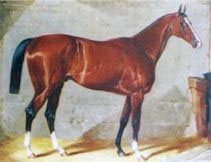St. Gatien
| St. Gatien | |
|---|---|

Painting of St. Gatien. Unknown artist.
|
|
| Sire | The Rover or Rotherhill |
| Dam | St Editha |
| Damsire | Kingley Vale |
| Sex | Stallion |
| Foaled | 1881 |
| Country | United Kingdom of Great Britain and Ireland |
| Colour | Bay |
| Breeder | E. Brace |
| Owner | E. Brace Jack Hammond |
| Trainer | Robert Sherwood James Waugh |
| Record | 19: 16-0-1 |
| Earnings | £ |
| Major wins | |
|
Epsom Derby (1884) Ascot Gold Vase (1884) Cesarewitch Handicap (1884) Jockey Club Cup (1884, 1885, 1886) Ascot Gold Cup (1885) Rous Memorial Stakes (1886) |
|
St. Gatien (1881–after 1906) was a British Thoroughbred racehorse and sire. In 1884 he was involved in the second and final dead heat in the history of the Epsom Derby, part of an unbeaten sequence of twelve races. St. Gatien went on to become a dominant performer in long distance races, winning the Gold Cup and the Alexandra Plate at Royal Ascot, the Cesarewitch Handicap carrying a record weight, and three successive running of the Jockey Club Cup.
In a racing career which lasted from 1883 until October 1886 he ran nineteen times, won sixteen races and was never beaten at level weights. He was regarded by contemporary experts as one of the greatest horses of the 19th century. At the end of the 1886 season he was retired to stud where he had success in England, Germany and the United States.
St. Gatien, bred by Major E. Brace, was a "grand, lengthy" bay horse with a white blaze and three white socks. Brace made several unsuccessful attempts to sell the colt for as little as £100, before putting him into training with Robert Sherwood at his Exeter House stable at Newmarket, Suffolk. Sherwood agreed to train the horse at a reduced rate of thirty shillings a week instead of the usual fifty as he had very few horses in his stable at the time. At the end of 1883, Brace succeeded in selling St. Gatien for £1,400 to Jack Hammond, a former stable-boy who had made his fortune as a professional gambler. In 1885, St. Gatien was moved to the stable of James Waugh.
St. Gatien’s pedigree was obscure and controversial as his dam, a former carriage-horse called Saint Editha, may have been covered by two stallions in the year of his conception. She was originally sent to a stallion named Rotherhill at Worcester Park, but when the covering appeared to have been unsuccessful, she was covered by The Rover, a "stilty-legged, broken down" horse, who happened to be at the same farm. Most contemporary commentators believed that St. Gatien’s sire was The Rover, but it is possible that he was sired by Rotherhill. Neither stallion got any other horses of notable racing merit. The success of St. Gatien provoked interest in The Rover, who was found to have been sold for £50 and was standing in Ireland at a fee of three guineas. On 19 November 1884 The Rover was killed when his throat was cut in his stable at Listowel. His death was the subject of a court case the following year in which his bankrupt owner was accused of the “malicious destruction” of the stallion to prevent him falling into the hands of his creditors.
...
Wikipedia
